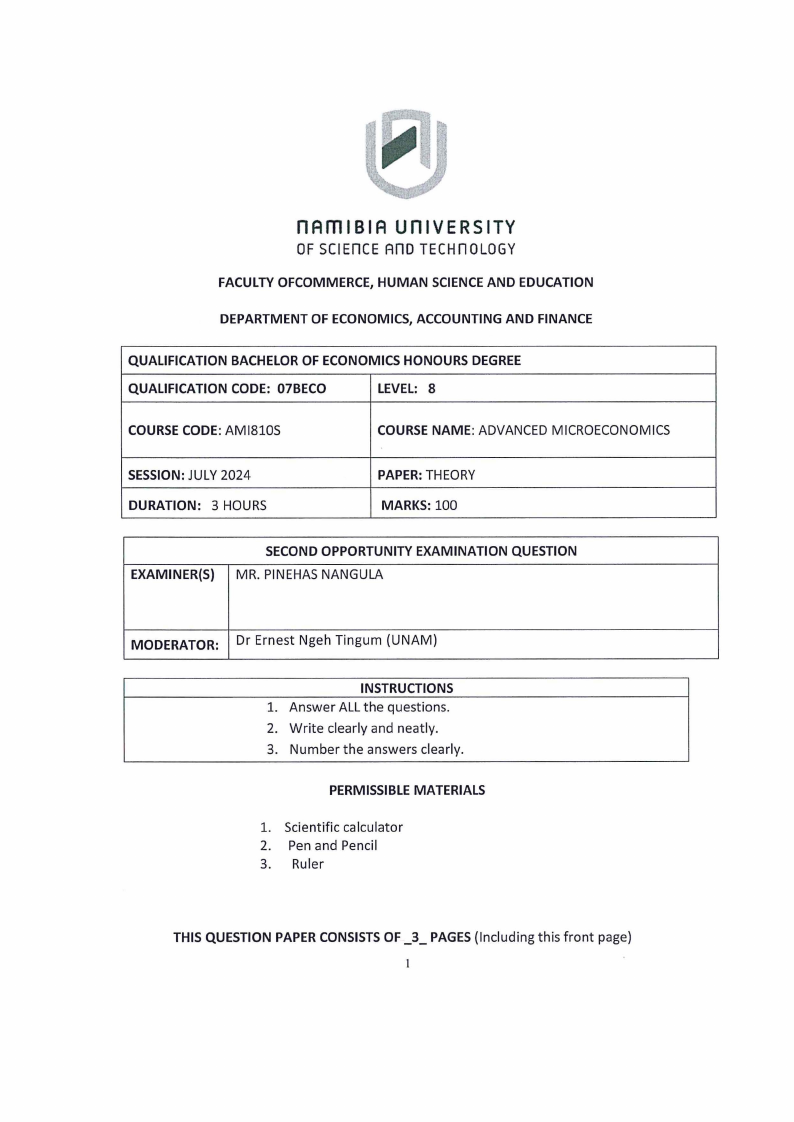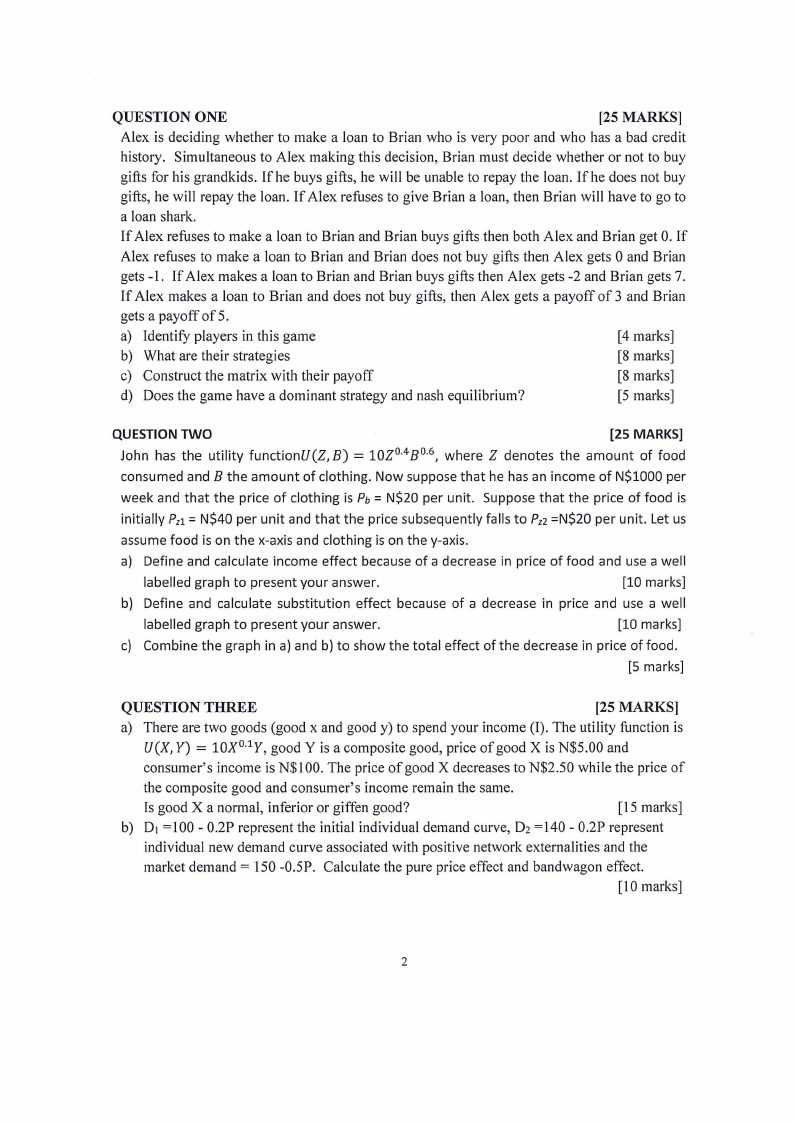 |
AMI810S-ADVANCED MICROECONOMICS-2ND OPP- JULY 2024 |
 |
1 Page 1 |
▲back to top |

n Am I BI A u n IVER s ITY
OF SCIEnCE Ano TECHnOLOGY
FACULTY OFCOMMERCE, HUMAN SCIENCE AND EDUCATION
DEPARTMENT OF ECONOMICS, ACCOUNTING AND FINANCE
QUALIFICATION BACHELOR OF ECONOMICS HONOURS DEGREE
QUALIFICATION CODE: 07BECO
LEVEL: 8
COURSE CODE: AMl810S
COURSE NAME: ADVANCED MICROECONOMICS
SESSION: JULY 2024
DURATION: 3 HOURS
PAPER: THEORY
MARKS: 100
EXAMINER(S)
SECOND OPPORTUNITY EXAMINATION QUESTION
MR. PINEHAS NANGULA
MODERATOR: Dr Ernest Ngeh Tingum (UNAM)
INSTRUCTIONS
1. Answer ALL the questions.
2. Write clearly and neatly.
3. Number the answers clearly.
PERMISSIBLE MATERIALS
1. Scientific calculator
2. Pen and Pencil
3. Ruler
THIS QUESTION PAPER CONSISTS OF _3_ PAGES (Including this front page)
 |
2 Page 2 |
▲back to top |

QUESTION ONE
[25 MARKS]
Alex is deciding whether to make a loan to Brian who is very poor and who has a bad credit
history. Simultaneous to Alex making this decision, Brian must decide whether or not to buy
gifts for his grandkids. If he buys gifts, he will be unable to repay the loan. Ifhe does not buy
gifts, he will repay the loan. If Alex refuses to give Brian a loan, then Brian will have to go to
a loan shark.
If Alex refuses to make a loan to Brian and Brian buys gifts then both Alex and Brian get 0. If
Alex refuses to make a loan to Brian and Brian does not buy gifts then Alex gets 0 and Brian
gets -1. If Alex makes a loan to Brian and Brian buys gifts then Alex gets -2 and Brian gets 7.
If Alex makes a loan to Brian and does not buy gifts, then Alex gets a payoff of 3 and Brian
gets a payoff of 5.
a) Identify players in this game
[4 marks]
b) What are their strategies
[8 marks]
c) Construct the matrix with their payoff
[8 marks]
d) Does the game have a dominant strategy and nash equilibrium?
[5 marks]
QUESTION TWO
[25 MARKS]
John has the utility functionU(Z, B) = 10ZD.4B0·6, where Z denotes the amount of food
consumed and B the amount of clothing. Now suppose that he has an income of N$1000 per
week and that the price of clothing is Pb = N$20 per unit. Suppose that the price of food is
initially Pz1 = N$40 per unit and that the price subsequently falls to Pz2 =N$20 per unit. Let us
assume food is on the x-axis and clothing is on the y-axis.
a) Define and calculate income effect because of a decrease in price of food and use a well
labelled graph to present your answer.
[10 marks]
b) Define and calculate substitution effect because of a decrease in price and use a well
labelled graph to present your answer.
[10 marks]
c) Combine the graph in a) and b) to show the total effect of the decrease in price of food.
[5 marks]
QUESTION THREE
[25 MARKS]
a) There are two goods (good x and goody) to spend your income (I). The utility function is
= U(X, Y) lOX 0·1 Y, good Y is a composite good, price of good Xis N$5.00 and
consumer's income is N$100. The price of good X decreases to N$2.50 while the price of
the composite good and consumer's income remain the same.
Is good X a normal, inferior or giffen good?
[15 marks]
b) D1 =100 - 0.2P represent the initial individual demand curve, D2 =140 - 0.2P represent
individual new demand curve associated with positive network externalities and the
market demand = 150 -0.5P. Calculate the pure price effect and bandwagon effect.
[10 marks]
2
 |
3 Page 3 |
▲back to top |

QUESTION FOUR
[25 MARKS]
a) Explain the difference between a positive and a negative network externality and give an
example of each.
[2 marks]
b) Explain in detail three microeconomics analytical tools.
[3 marks]
c) David is considering his purchases of food (x) and clothing (y). He has the utility function
U(x,y) = xy + lOx, his income is N$10.00, price of good xis N$1.00 and price of good
y is N$2.00. Does David have an interior or a corner solution? Please calculate the
interior and corner solution
[10 marks]
d) An individual consumes two goods, clothing and food. Given the information below,
illustrate both the income-consumption curve and the Engel curve for clothing and food.
[10 marks]
Price of food
N$10
N$10
N$10
N$10
Price of cloth
N$2
N$2
N$2
N$2
Quantity
food
6
8
11
15
of Quantity cloth Income
20
N$100
35
N$150
45
N$200
50
N$250
All the best
3





